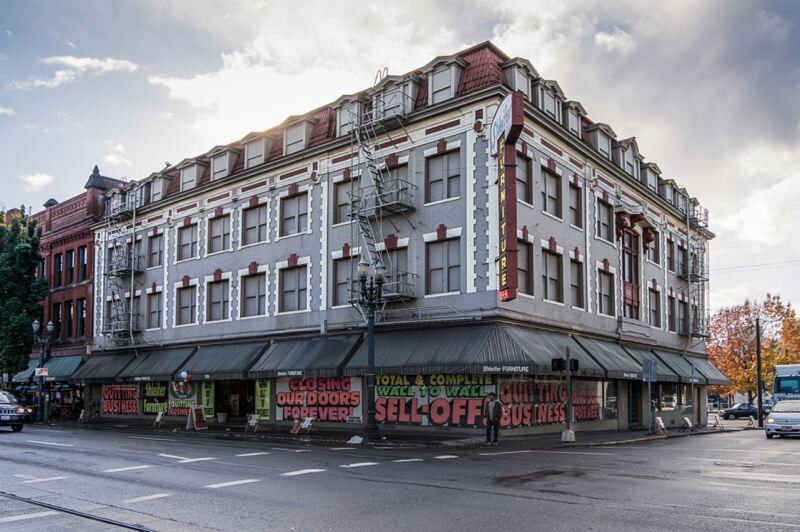NO VACANCY
Published 12:00 am Friday, May 20, 2016

- The Shleifer Warehouse, one of Beam Developments current projects, is being adapted into a creative office from a furniture warehouse. Development hasnt started yet, but Beam is already talking to potential future users.
Industrial space vacancy rates reached an all-time low of 3.6 percent in 2016 Q1, while demand for it soared to a record of 11 percent higher in March than any previous month on record.
Trending
That’s according to a study released by Jones Lang LaSalle Portland (JLL), a firms specializing in commercial real estate services and investment management.
It’s no secret that commercial and industrial real estate in Portland is climbing in demand and worth. JLL’s annual study found Portland’s industrial supply is struggling to develop and redevelop space quickly enough.
According to the JLL study, “Portland’s growing stature as a distribution hub in the Pacific Northwest is bringing in large corporations looking to establish and consolidate their distribution footprint.”
Trending
The JLL research corresponds with findings from the annual Central City Development and Redevelopment Projects report, prepared this May by Heritage Consulting Group for the Portland Business Alliance (see “Downtown building boom reshapes Portland’s skyline” by Joseph Gallivan, page 5).
The May development report found that while Portland has historically been an attractive second-tier real estate market as the largest city between San Francisco and Seattle, 2016 saw Rose City’s real estate marketplace explode across a broad number of sectors in nearly every geographic area.
“To a large degree, it is believed that this growth represents a solidification of Portland as an alternative preferred location in the Pacific Northwest,” the report found.
Although the May development report focuses mostly on the traditional markets for office, retail, hotel and residential real estate developments in Central City, the PBA’s Lisa Frisch sees the connection to industrial markets.
“The report’s about the central city, and traditionally that’s not a huge industrial market in Portland … most of the real estate in the central city is either retail, office or housing,” Frisch said. “I’d say since all three retail, office and residential vacancy rates are very low, I could see how that could also extend to industrial being very low.”
Frisch said she and the PBA have never seen so many projects simultaneously underway, with a long pipeline of more developments queuing up.
“We are listing 39 active construction projects, and during the height of the recession we listed eight,” Frisch said. “Actually, we’ve never had as many in the 15-year or more history of this report.”
Central City Activity
The May report attributes the industrial growth to record low vacancy rates across all sectors. Of the active projects, the report names a handful of current projects under Beam Development including 811 Stark, The Slate, Shleifer Furniture Warehouse and Hotel Chamberlain.
Brad Malsin, owner of Beam Development, said he doesn’t necessarily consider all of those to be industrial sector, but 811 Stark started leasing all its space before it was halfway constructed and is currently 90 percent leased. Although all four floors are framed up, the building’s outer skin isn’t yet complete.
“We certainly feel the market is strong, so of course hitting the market at the right time is obviously important,” Malsin said. “We’re anxious to move these along.”
811 Stark is a mixed-use creative office with retail ready for occupancy this autumn. It has 24,000 square feet of office space above 2,600 square feet of retail. The architect firm is Works Partnership.
Malsin said The Slate was also leased during construction and is now “90 percent leased at this moment in terms of the commercial space.”
The Slate (321 N.E. Couch St.) is also designed by Works Partnership Architecture in conjunction with Urban Development Partners, Beam Development and Yorke & Curtis contractors.
It’s a $24.5 million, 10-story mixed-use project planned at the east Burnside Bridgehead. Its plans include 32,000 square feet of flexible office space on floors 2-4, and 74 housing units above. Completion is slated for later this year.
As for Hotel Chamberlain and the Shleifer Warehouse, Beam Development owns it but hasn’t started development yet.
“We’re still in the process of planning and design,” Malsin said. But, already “We’re talking to a number of potential hoteliers that might be a part of the Chamberlain Hotel, and we’re talking to a number of users for the Shleifer Warehouse.”
The Shleifer Warehouse, 224 S.E. Second Ave., is an adaption of a 1936 warehouse building into creative offices. Urban Development Partners is working on it with Beam. Schleifer recently retired and closed the building
The Chamberlain Hotel, 509 S.E. Grand Ave., is being developed by a partnership of Beam Development, Urban Development Partners and Emerick Architects. It’s a redevelopment project of a 1897, quarter-block building.
Large Square Footage in Demand
JLL is tracking 3.4 million square feet of industrial demand, and found 1.75 million square feet is developed for tenants seeking spaces larger than 200,000 square feet — a trend commonly found in the Columbia Corridor, Silicon Forest and all around Portland’s other industrial areas this year.
“Of note regarding demand in the market is the increasing number of users looking for larger blocks of space, in excess of 100,000 square feet, a significant size for Portland,” the study said.
In the rush of demand, Malsin said Beam is able to stand out as a developer in its particular niche.
“It’s both being able to serve the large users, but as important is being able to provide opportunity for the smaller startups and the rapidly growing tech firms that need space quickly, with a lot of flexibility to their leasing,” Malsin said. “We like responding to those. We try to mix it — honestly, we like the mixture of different-sized tenants at different levels of sophistications.”
Early this year, large spaces — more than 425,000 square feet total — were absorbed by distributors including LKW, Logistics Insights Corporation and Bell-Carter, according to JLL.
“Making sure we provide an opportunity for startups, we feel that’s part of our commitment to the city and to the district,” Malsin said.
The JLL study found that until 2015, Portland saw below-average delivery on real estate since 2008, but in the past five years demand has far exceeded supply.
During Q1, Portland saw 290,332 square feet of new warehouse, distribution and manufacturing space delivered along with more than 2.2 million square feet under construction with completion dates later this year, JLL found.
“The (May development) report highlights a very low availability in those sectors, and a flurry of construction activity to bring new product online and alleviate the inventory shortage,” Frisch said. “We’ve never seen so many projects currently underway, and then the pipeline of projects ready to go soon is also just a little bit crazy … It’s all really good news.”
Unless you’re an occupant on tight budget: According to the JLL study, asking rents started the year at $0.52 per square foot, a 4 percent increase from last quarter. Asking rents for new construction are being quoted as high as $0.55 per square foot with office surcharges reaching a rate of $0.85.
Even if affordability isn’t an issue, there will still be competition vying for your dream work space.
Leases at new construction projects slated for 2016 completions will add 1.3 million square feet of activity, according to JLL. But it’s not enough for everybody: JLL found the demand from tenants in the market for Q1 is now at 3.9 million square feet.







